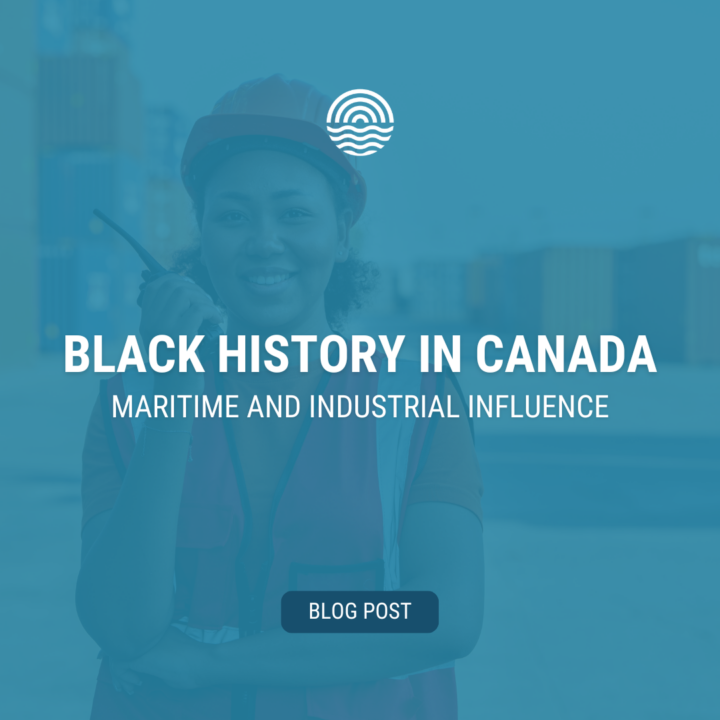
BLOG POST
Black History in Canada: Maritime and Industrial Influence
Early Black history in Canada is deeply intertwined with the nation’s maritime and industrial development.
From the earliest days of fur trade to the industrial boom of the 19th and 20th centuries, Black Canadians played a vital role in shaping the Canadian landscape.
The Fur Trade (17th to 19th Century)
The role of Black people within the Canadian history of the fur trade has often been overlooked.
Black individuals were active participants in the fur trade, a cornerstone of early Canadian economy. However, historical records primarily focus on European traders, while the contributions of Black individuals have largely been undocumented.
Despite these challenges, historical research has revealed the presence of several Black fur traders, including entire families, who played significant roles in this crucial industry.
- Joseph Lewis: Lewis was an early Black fur trader originally from the United States. He was likely the first Black person on record in the territories that later became Saskatchewan and Alberta. Lewis was among the few Black individuals known to have participated in the fur trade’s westward expansion into the Canadian Northwest during the late 18th and early 19th centuries, a period of significant industry growth.
- The Bonga Family: This prominent family of fur traders, originally enslaved, achieved significant success. Pierre Bonga worked with renowned explorers and served as a translator. His sons, Stephen and George, continued the family tradition, becoming successful traders, translators, and community leaders.
The Impact of the American Revolution (18th Century)
The American Revolution brought a wave of Black Loyalists to Canada from 1775-1783.
During the American Revolution, thousands of enslaved and free Black people fought for the British, hoping for freedom and land. The British, facing defeat, promised these rewards to Black Loyalists. However, after the war, many of these promises were broken.
A significant number of Black Loyalists settled in Nova Scotia and New Brunswick. They encountered numerous challenges, including poverty, forced labour, denial of equal rights, racism, and land dispossession. Similar struggles faced Black Loyalists who settled in Upper and Lower Canada.
The arrival of Black Loyalists to Canada had a profound impact on the social, economic, and cultural aspects of early maritime communities. They brought new skills and perspectives, enriching the region’s diversity. While facing significant challenges, including racism and limited land ownership, Black Loyalists contributed to the growth of these communities. Their struggle for equality and their rich cultural heritage continue to shape Canadian society today.
In fact, the heritage and legacy of Black Loyalists are commemorated in institutions like the Black Loyalist Heritage Centre in Shelburne and the Black Cultural Centre for Nova Scotia in Cherry Brook. This recognition extends beyond physical spaces, with the Royal Canadian Mint issuing a commemorative silver coin in February 2021. The coin features the coat of arms of the Black Loyalist Heritage Society, carrying their motto: “The heart of your knowledge is in your roots.”
The Railway and the Emergence of Black Communities in Canada (19th and 20th Centuries)
In the 19th and 20th centuries, Black Canadians continued to make significant contributions to Canada’s maritime and industrial sectors.
This era was heavily influenced by the flourishing railway industry:
- Railroad Migration: Many African Americans migrated to Canada to work as porters on the expanding railway network. This led to the establishment of thriving Black communities around major train stations in cities like Montreal, Toronto, and Winnipeg.
- Maritime Connections: In the Maritimes, West Indian migrants found employment in coal mines, steel mills, and shipyards, further contributing to the growth of Black communities in these regions.
- Community Building: These communities developed strong social and cultural institutions, including churches and fraternal organizations, to support their members and foster a sense of belonging.
While these migrations provided economic opportunities, Black Canadians faced significant challenges, including racism and limited social mobility.
A Legacy of Resilience and Contribution
The history of Black Canadians is inextricably linked to the development of Canada’s maritime and industrial sectors. From their participation in the fur trade to their vital roles in the railway industry and maritime sectors, Black Canadians have significantly shaped Canada’s economic and social landscape.
While facing systemic racism and discrimination, Black Canadians have persevered, building strong communities and making invaluable contributions to the country’s progress. Recognizing and celebrating this rich history is crucial for understanding the diverse tapestry of Canada – both past and present.
Ready to make your workplace more inclusive for all?
We’re here to help! Get in touch to learn more about implementing DEI initiatives that will drive meaningful change within your organization and across the waterfront.


